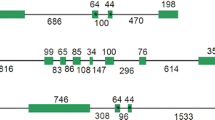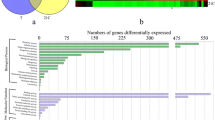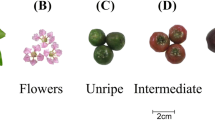Abstract
ATP-citrate lyase (ACL, EC4.1.3.8) catalyzes citrate to oxaloacetate and acetyl-CoA in the cell cytosol, and has important roles in normal plant growth and in the biosynthesis of some secondary metabolites. We identified three ACL genes, CitACLα1, CitACLα2, and CitACLβ1, in the citrus genome database. Both CitACLα1 and CitACLα2 encode putative ACL α subunits with 82.5 % amino acid identity, whereas CitACLβ1 encodes a putative ACL β subunit. Gene structure analysis showed that CitACLα1 and CitACLα2 had 12 exons and 11 introns, and CitACLβ1 had 16 exons and 15 introns. CitACLα1 and CitACLβ1 were predominantly expressed in flower, and CitACLα2 was predominantly expressed in stem and fibrous roots. As fruits ripen, the transcript levels of CitACLα1, CitACLβ1, and/or CitACLα2 in cultivars ‘Niuher’ and ‘Owari’ increased, accompanied by significant decreases in citrate content, while their transcript levels decreased significantly in ‘Egan No. 1’ and ‘Iyokan’, although citrate content also decreased. In ‘HB pummelo’, in which acid content increased as fruit ripened, and in acid-free pummelo, transcript levels of CitACLα2, CitACLβ1, and/or CitACLα1 increased. Moreover, mild drought stress and ABA treatment significantly increased citrate contents in fruits. Transcript levels of the three genes were significantly reduced by mild drought stress, and the transcript level of only CitACLβ1 was significantly reduced by ABA treatment. Taken together, these data indicate that the effects of ACL on citrate use during fruit ripening depends on the cultivar, and the reduction in ACL gene expression may be attributed to citrate increases under mild drought stress or ABA treatment.





Similar content being viewed by others
References
Albertini M-V, Carcouet E, Pailly O, Gambotti C, Luro F, Berti L (2006) Changes in organic acids and sugars during early stages of development of acidic and acidless citrus fruit. J Agric Food Chem 54:8335–8339
Baldwin EA (1993) Citrus fruit. In: Seymour GB, Taylor JE, Tucker GA (eds) Biochemistry of fruit ripening. Chapman & Hall, London, pp 107–149
Bartolozzi F, Bertazza G, Bassi D, Cristoferi G (1997) Simultaneous determination of soluble sugars and organic acids as their trimethylsilyl derivatives in apricot fruits by gas–liquid chromatography. J Chromatogr A 758:99–107
Bastías A, López-Climent M, Valcárcel M, Rosello S, Gómez-Cadenas A, Casaretto JA (2011) Modulation of organic acids and sugar content in tomato fruits by an abscisic acid-regulated transcription factor. Physiol Plant 141:215–226
Cercós M, Soler G, Iglesias D, Gadea J, Forment J, Talón M (2006) Global analysis of gene expression during development and ripening of citrus fruit flesh. A proposed mechanism for citric acid utilization. Plant Mol Biol 62:513–527
Chávez-Cabrera C, Flores-Bustamante Z, Marsch R, Montes MdC, Sánchez S, Cancino-Díaz J, Flores-Cotera L (2010) ATP-citrate lyase activity and carotenoid production in batch cultures of Phaffia rhodozyma under nitrogen-limited and nonlimited conditions. Appl Microbiol Biotechnol 85:1953–1960
Chypre M, Zaidi N, Smans K (2012) ATP-citrate lyase: a mini-review. Biochem Biophys Res Commun 422:1–4
Crifò T, Puglisi I, Petrone G, Recupero GR, Lo Piero AR (2011) Expression analysis in response to low temperature stress in blood oranges: implication of the flavonoid biosynthetic pathway. Gene 476:1–9
Crifò T, Petrone G, Lo Cicero L, Lo Piero AR (2012) Short cold storage enhances the anthocyanin contents and level of transcripts related to their biosynthesis in blood oranges. J Agric Food Chem 60:476–481
Degu A, Hatew B, Nunes-Nesi A, Shlizerman L, Zur N et al (2011) Inhibition of aconitase in citrus fruit callus results in a metabolic shift towards amino acid biosynthesis. Planta (Berlin) 234:501–513
Fatland BL, Ke J, Anderson MD, Mentzen WI, Cui LW et al (2002) Molecular characterization of a heteromeric ATP-citrate lyase that generates cytosolic acetyl-coenzyme a in Arabidopsis. Plant Physiol 130:740–756
Fatland BL, Nikolau BJ, Wurtele ES (2005) Reverse genetic characterization of cytosolic acetyl-CoA generation by ATP-citrate lyase in Arabidopsis. Plant Cell 17:182–203
Guo A-Y, Zhu Q-H, Chen X, Luo J-C (2007) GSDS: a gene structure display server. Yi chuan 29:1023
Higo K, Ugawa Y, Iwamoto M, Korenaga T (1999) Plant cis-acting regulatory DNA elements (PLACE) database: 1999. Nucl Acid Res 27:297–300
Jiang N, ** L-F, Teixeira da Silva JA, Islam MDZ, Gao H-W, Liu Y-Z, Peng S-A (2014) Activities of enzymes directly related with sucrose and citric acid metabolism in citrus fruit in response to soil plastic film mulch. Sci Hortic 168:73–80
Katz E, Fon M, Lee YJ, Phinney BS, Sadka A, Blumwald E (2007) The citrus fruit proteome: insights into citrus fruit metabolism. Planta 226:989–1005
Katz E, Boo KH, Kim HY, Eigenheer RA, Phinney BS et al (2011) Label-free shotgun proteomics and metabolite analysis reveal a significant metabolic shift during citrus fruit development. J Exp Bot 62:5367–5384
Koressaar T, Remm M (2007) Enhancements and modifications of primer design program Primer3. Bioinformatics 23:1289–1291
Langlade NB, Messerli G, Weisskopf L, Plaza S, Tomasi N et al (2002) ATP citrate lyase: cloning, heterologous expression and possible implication in root organic acid metabolism and excretion. Plant Cell Environ 25:1561–1569
Li C-N, Qian N, Tan Q-L, Manoj KS, Li-Tao Y, Li Y-R (2012) Cloning and expression analysis of ATP-citrate lyase genes from sugarcane. Acta Agron Sin 38:2024–2033
Liu YZ, Liu Q, Tao NG, Deng XX (2006) Efficient isolation of RNA from fruit peel and pulp of ripening navel orange (Citrus sinensis Osbeck). J Huazhong Agric Univ 25:300–304
Liu X, Hu X-M, ** L-F, Shi C-Y, Liu Y-Z, Peng S-A (2014) Identification and transcript analysis of two glutamate decarboxylase genes, CsGAD1 and CsGAD2, reveal the strong relationship between CsGAD1 and citrate utilization in citrus fruit. Mol Biol Rep. doi:10.1007/s11033-11014-13506-x
Livak KJ, Schmittigen TD (2001) Analysis of relative gene expression data using real-time quantitative PCR and the 2(-delta delta C(T)) method. Methods 25:402–408
Lo Piero A, Lo Cicero L, Puglisi I (2014) The metabolic fate of citric acid as affected by cold storage in blood oranges. J Plant Biochem Biotechnol 23:161–166
Navarro JM, Pérez-Pérez JG, Romero P, Botía P (2010) Analysis of the changes in quality in mandarin fruit, produced by deficit irrigation treatments. Food Chem 119:1591–1596
Nelson DR, Rinne RW (1975) Citrate cleavage enzymes from develo** soybean cotyledons incorporation of citrate carbon into fatty acids. Plant Physiol 55:69–72
Popova TN, Pinheiro de Carvalho MA (1998) Citrate and isocitrate in plant metabolism. Biochim Biophys Acta 1364:307–325
Rangasamy D, Ratledge C (2000) Compartmentation of ATP: citrate lyase in plants. Plant Physiol 122:1225–1230
Sadka A, Dahan E, Cohen L, Marsh KB (2000) Aconitase activity and expression during the development of lemon fruit. Physiol Plant 108:255–262
Terol J, Soler G, Talon M, Cercos M (2010) The aconitate hydratase family from Citrus. BMC Plant Biol 10:222
Thompson JD, Gibson TJ, Plewniak F, Jeanmougin F, Higgins DG (1997) The CLUSTAL_X windows interface: flexible strategies for multiple sequence alignment aided by quality analysis tools. Nucl Acid Res 25:4876–4882
**ng S, van Deenen N, Magliano P, Frahm L, Forestier E et al (2014) ATP citrate lyase activity is post-translationally regulated by sink strength and impacts the wax, cutin and rubber biosynthetic pathways. Plant J 79:270–284
Xu Q, Chen LL, Ruan X, Chen D, Zhu A et al (2012) The draft genome of sweet orange (Citrus sinensis). Nat Genet 45:59–66
Zaidi N, Swinnen JV, Smans K (2012) ATP-citrate lyase: a key player in cancer metabolism. Cancer Res 72:3709–3714
Zhou GF, Peng SA, Liu YZ, Wei QJ, Han J, Islam MZ (2014) The physiological and nutritional responses of seven different citrus rootstock seedlings to boron deficiency. Trees 28:295–307
Acknowledgments
This work was supported by the National Natural Science Foundation of China (No. 31372012).
Author information
Authors and Affiliations
Corresponding author
Additional information
Communicated by S. Hohmann.
Electronic supplementary material
Below is the link to the electronic supplementary material.
Rights and permissions
About this article
Cite this article
Hu, XM., Shi, CY., Liu, X. et al. Genome-wide identification of citrus ATP-citrate lyase genes and their transcript analysis in fruits reveals their possible role in citrate utilization. Mol Genet Genomics 290, 29–38 (2015). https://doi.org/10.1007/s00438-014-0897-2
Received:
Accepted:
Published:
Issue Date:
DOI: https://doi.org/10.1007/s00438-014-0897-2




